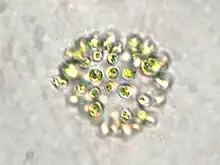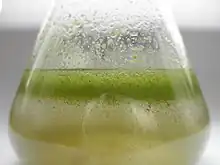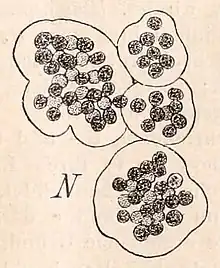Microcystis
| Microcystis | |
|---|---|
 | |
| Microcystis aeruginosa | |
| Scientific classification | |
| Domain: | Bacteria |
| Phylum: | Cyanobacteria |
| Class: | Cyanophyceae |
| Order: | Chroococcales |
| Family: | Microcystaceae |
| Genus: | Microcystis Kützing, 1833 |
| Species | |
|
Many (see below) | |
Microcystis is a genus of freshwater cyanobacteria that includes the harmful algal bloom-forming Microcystis aeruginosa. Many members of a Microcystis community can produce neurotoxins and hepatotoxins, such as microcystin and cyanopeptolin. Communities are often a mix of toxin-producing and nonproducing isolates. [1]
Etymology
The genus Microcystis derives from the Greek[2] mikros (small) + kystis (bladder)
Physical characteristics

As the etymological derivation implies, Microcystis is characterized by small cells (a few micrometers in diameter), possessing gas-filled vesicles (also lacking individual sheaths).[2] The cells are usually organized into colonies (aggregations of which are visible with the naked eye) that begin in a spherical shape, losing coherence to become perforated or irregularly shaped over time. These colonies are bound by a thick mucilage composed of complex polysaccharide compounds, including xylose, mannose, glucose, fucose, galactose, and rhamnose, among other compounds.[3]
The coloration of the protoplast is a light blue-green, appearing dark or brown due to optical effects of gas-filled vesicles.
Ecology


Microcystis is capable of producing large surface blooms through a combination of rapid division and buoyancy regulation by production of gas-filled vesicles. In nature, Microcystis can exist as single cells or in large colonies containing many cells. Their ability to regulate buoyancy is key to their dominance of eutrophic waters, by optimally positioning themselves within the photic zone in a stable water column.
Because they can form large surface blooms, they are thought to be able to outcompete other phytoplankton by monopolizing light in the photic zone.
Microcystis spp. are also capable of strong uptake of phosphate and nitrogen; they are believed to strongly influence nitrogen to phosphorus ratios (N:P ratio).[4] Microcystis cells are also efficient at assimilating carbon from their environment; during large blooms, rampant photosynthesis can drive the pH of communities to < 9.0. [5] Recent efforts have suggested a combination of effective carbon-concentrating mechanisms and a potential ability to use urea as a carbon source allows Microcystis to persist under these high-pH conditions.
In South Africa, Hartebeestpoort Dam is highly impacted by Microcystis because of elevated phosphate and nitrate levels flowing from the sewers of Johannesburg, one of the few cities in the world that straddles a continental watershed divide,[6] so lies upstream of major dams and rivers.[7]
In North America, Microcystis blooms have caused issues in numerous freshwater systems over the last two decades. These include large lakes (Erie, Okeechobee) and small regional water masses. In 2014, detection of the microcystin toxin in treated water of Toledo (OH) resulted in a shutdown of the water supply to more than 400,000 residents. The breakthrough of the toxin in the system was linked to the presence of a virus that lysed cells and released the toxin out of particles into the dissolved phase. [8]
Health risks
Cyanobacteria can produce neurotoxins and hepatotoxins, such as microcystin and cyanopeptolin.[9][10] Microcystis has also been reported to produce a compound (or compounds) that can have endocrine-disrupting effects. [11] In 2018, the Great Lakes Center for Fresh Waters and Human Health was founded at Bowling Green State University (OH) with a focus on problems associated with Microcystis blooms in the Laurentian Great Lakes. Under the leadership of inaugural director George S. Bullerjahn, the center engages scientists from nine institutions across six states, and is supported by combined funding from the National Science Foundation and National Institute of Environmental Health Sciences.
Species
Microcystis species include:[12]
- Microcystis aeruginosa
- Microcystis argentea
- Microcystis botrys
- Microcystis elongata
- Microcystis flos-aquae
- Microcystis holsatica
- Microcystis lutescens
- Microcystis marina
- Microcystis pallida
- Microcystis panniformis
- Microcystis salina
- Microcystis thermalis
- Microcystis viridis
- Microcystis wesenbergii
See also
- Pandorina (Analogy)
References
- ↑ Rinta-Kanto, J. M.; Ouellette, A. J. A.; Boyer, G. L.; Twiss, M. R.; Bridgeman, T. B.; Wilhelm, S. W. (June 2005). "Quantification of Toxic Microcystis spp. during the 2003 and 2004 Blooms in Western Lake Erie using Quantitative Real-Time PCR". Environmental Science & Technology. 39 (11): 4198–4205. Bibcode:2005EnST...39.4198R. doi:10.1021/es048249u. ISSN 0013-936X. PMID 15984800.
- 1 2 "Cyanobacteria: Microcystis". The Silica Secchi Disk. Connecticut College: The SilicaSecchi Disk. Archived from the original on March 26, 2008. Retrieved 24 June 2011.
- ↑ Thomas Rohrlack, Manfred Henning and Johannes-Günter Kohl (1999). "Mechanisms of the inhibitory effect of the cyanobacterium Microcystis aeruginosa on Daphnia galeata's ingestion rate" (PDF). Journal of Plankton Research. 73 (5): 980–984. doi:10.1021/np900818c. PMID 20405925.
{{cite journal}}: CS1 maint: uses authors parameter (link) - ↑ Xie, Liqiang; Xie, Ping; Li, Sixin; Tang, Huijuan; Liu, Hong (2003). "The low TN:TP ratio, a cause or a result of Microcystis blooms?". Water Research. 37 (9): 2073–2080. doi:10.1016/S0043-1354(02)00532-8. PMID 12691892.
- ↑ Krausfeldt, Lauren E.; Farmer, Abigail T.; Castro Gonzalez, Hector F.; Zepernick, Brittany N.; Campagna, Shawn R.; Wilhelm, Steven W. (2019-05-17). "Urea Is Both a Carbon and Nitrogen Source for Microcystis aeruginosa: Tracking 13C Incorporation at Bloom pH Conditions". Frontiers in Microbiology. 10: 1064. doi:10.3389/fmicb.2019.01064. ISSN 1664-302X. PMC 6536089. PMID 31164875.
- ↑ Turton, A.R., Schultz, C., Buckle, H, Kgomongoe, M., Malungani, T. & Drackner, M. 2006. Gold,efore Scorched Earth and Water: The Hydropolitics of Johannesburg. In Water Resources Development, Vol. 22., No. 2; 313-335.
- ↑ Turton, A.R. 2015. Sitting on the Horns of a Dilemma: Water as a Strategic Resource in South Africa. In @Liberty, No 6, Issue 22. Johannesburg: South African Institute of Race Relations. Available online http://irr.org.za/reports-and-publications/atLiberty/files/liberty-2013-sitting-on-the-horns-of-a-dilemma-2013-water-as-a-strategic-resource-in-south-africa Archived 2017-10-04 at the Wayback Machine
- ↑ Steffen, Morgan M.; Davis, Timothy W.; McKay, R. Michael L.; Bullerjahn, George S.; Krausfeldt, Lauren E.; Stough, Joshua M.A.; Neitzey, Michelle L.; Gilbert, Naomi E.; Boyer, Gregory L.; Johengen, Thomas H.; Gossiaux, Duane C. (2017-06-20). "Ecophysiological Examination of the Lake Erie Microcystis Bloom in 2014: Linkages between Biology and the Water Supply Shutdown of Toledo, OH". Environmental Science & Technology. 51 (12): 6745–6755. Bibcode:2017EnST...51.6745S. doi:10.1021/acs.est.7b00856. ISSN 0013-936X. PMID 28535339.
- ↑ Tooming-Klunderud, Ave (2007). "On the Evolution of Nonribosomal Peptide Synthetase Gene Clusters in Cyanobacteria". University of Oslo.
{{cite journal}}: Cite journal requires|journal=(help) - ↑ Karl Gademann, Cyril Portmann, Judith F. Blom, Michael Zeder and Friedrich Jüttner (2010). "Multiple Toxin Production in the Cyanobacterium Microcystis: Isolation of the Toxic Protease Inhibitor Cyanopeptolin 1020" (PDF). J. Nat. Prod. 73 (5): 980–984. doi:10.1021/np900818c. PMID 20405925.
{{cite journal}}: CS1 maint: uses authors parameter (link) - ↑ Rogers, Emily D.; Henry, Theodore B.; Twiner, Michael J.; Gouffon, Julia S.; McPherson, Jackson T.; Boyer, Gregory L.; Sayler, Gary S.; Wilhelm, Steven W. (March 2011). "Global Gene Expression Profiling in Larval Zebrafish Exposed to Microcystin-LR and Microcystis Reveals Endocrine Disrupting Effects of Cyanobacteria". Environmental Science & Technology. 45 (5): 1962–1969. Bibcode:2011EnST...45.1962R. doi:10.1021/es103538b. ISSN 0013-936X. PMID 21280650.
- ↑ "Taxonomy Browser Genus: Microcystis". AlgaeBase. Retrieved 24 June 2011.